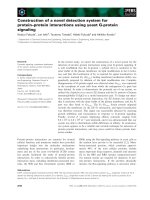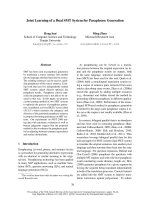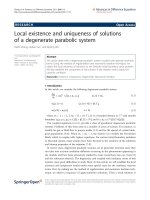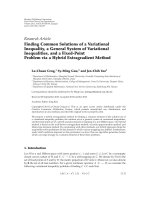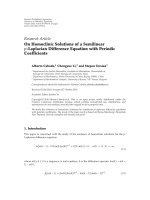PERIODIC SOLUTIONS OF A DISCRETE-TIME DIFFUSIVE SYSTEM GOVERNED BY BACKWARD DIFFERENCE pdf
Bạn đang xem bản rút gọn của tài liệu. Xem và tải ngay bản đầy đủ của tài liệu tại đây (526.07 KB, 12 trang )
PERIODIC SOLUTIONS OF A DISCRETE-TIME
DIFFUSIVE SYSTEM GOVERNED BY
BACKWARD DIFFERENCE EQUATIONS
BINXIANG DAI AND JIEZHONG ZOU
Received 22 November 2004 and in revised form 16 January 2005
A discrete-time delayed diffusion model governed by backward difference equations is
investigated. By using the coincidence degree and the related continuation theorem as
well as some priori estimates, easily verifiable sufficient criteria are established for the
existence of positive periodic solutions.
1. Introduction
Recently, some biologists have argued that the ratio-dependent predator-prey model is
more appropriate than the Gauss-type models for modelling predator-prey interactions
where predation involves searching processes. This is strongly supported by numerous
laboratory experiments and observations [1, 2, 3, 4, 10, 11, 12]. Many authors [1, 5, 7, 13,
14] have observed that the ratio-dependent predator-prey systems exhibit much richer,
more complicated, and more reasonable or acceptable dynamics. In view of p eriodicity
of the actual environment, Chen et al. [6] considered the following two-species ratio-
dependent predator-prey nonautonomous diffusion system with time delay:
˙
x
1
(t) = x
1
(t)
a
1
(t) − a
11
(t)x
1
(t) −
a
13
(t)x
3
(t)
m(t)x
3
(t)+x
1
(t)
+ D
1
(t)
x
2
(t) − x
1
(t)
,
˙
x
2
(t) = x
2
(t)
a
2
(t) − a
22
(t)x
2
(t)
+ D
2
(t)
x
1
(t) − x
2
(t)
,
˙
x
3
(t) = x
3
(t)
− a
3
(t)+
a
31
(t)x
1
(t − τ)
m(t)x
3
(t − τ)+x
1
(t − τ)
,
(1.1)
where x
i
(t) represents the prey population in the ith patch (i = 1,2), and x
3
(t) represents
the predator population, τ>0 is a constant delay due to gestation, and D
i
(t) denotes the
dispersal rate of the prey in the ith patch (i = 1,2). D
i
(t)(i = 1,2), a
i
(t)(i = 1,2,3), a
11
(t),
a
13
(t), a
22
(t), a
31
(t), and m(t) are strictly positive continuous ω-periodic functions. The y
proved that system (1.1) has at least one positive ω-periodic solution if the conditions
a
31
(t) >a
3
(t)andm(t)a
1
(t) >a
13
(t) are satisfied.
Copyright © 2005 Hindawi Publishing Corporation
Advances in Difference Equations 2005:3 (2005) 263–274
DOI: 10.1155/ADE.2005.263
264 Periodic solutions of a discrete-time diffusive system
One question arises naturally. Does the discrete analog of system (1.1) have a posi-
tive periodic solution? T he purpose of this paper is to answer this question to some ex-
tent. More precisely, we consider the following discrete-time diffusion system governed
by backward difference equations:
x
1
(k) = x
1
(k − 1)exp
a
1
(k) − a
11
(k)x
1
(k) −
a
13
(k)x
3
(k)
m(k)x
3
(k)+x
1
(k)
+ D
1
(k)
x
2
(k) − x
1
(k)
x
1
(k)
,
x
2
(k) = x
2
(k − 1)exp
a
2
(k) − a
22
(k)x
2
(k)+D
2
(k)
x
1
(k) − x
2
(k)
x
2
(k)
,
x
3
(k) = x
3
(k − 1)exp
− a
3
(k)+
a
31
(k)x
1
(k − l)
m(k)x
3
(k − l)+x
1
(k − l)
(1.2)
with initial condition
x
i
(−m) ≥ 0, m = 1,2, ,l; x
i
(0) > 0(i = 1,2,3), (1.3)
where D
i
(k)(i = 1,2), a
i
(k)(i = 1,2,3), a
11
(k), a
13
(k), a
22
(k), a
31
(k), m(k)arestrictly
positive ω-periodic sequence, that is,
D
i
(k + ω) = D
i
(k), i = 1,2,
a
i
(k + ω) = a
i
(k), i = 1,2,3,
a
11
(k + ω) = a
11
(k), a
13
(k + ω) = a
13
(k),
a
22
(k + ω) = a
22
(k), a
31
(k + ω) = a
31
(k),
m(k + ω) = m(k)
(1.4)
for arbitrary integer k,whereω, a fixed positive integer, denotes the prescribed common
period of the parameters in (1.2).
It is well known that, compared to the continuous-time systems, the discrete-time ones
aremoredifficult to deal with. To the best of our knowledge, no work has been done for
thediscrete-timesystemanalogueof(1.1). Our purpose in this paper is, by using the
continuation theorem of coincidence degree theory [9], to establish sufficient conditions
for the existence of at least one positive ω-periodic solution of system (1.2).
Let
Z, Z
+
, R, R
+
,andR
3
denote the sets of all integers, nonnegative integers, real
numbers, nonnegative real numbers, and the three-dimensional Euclidean vector space,
respectively .
B. Dai and J. Zou 265
For convenience, we introduce the following notation:
I
ω
={1,2, ,ω},
¯
u =
1
ω
ω
k=1
u(k),
u
L
= min
k∈I
ω
u(k), u
M
= max
k∈I
ω
u(k),
(1.5)
where u(k)isanω-periodic sequence of real numbers defined for k ∈ Z.
Our main result in this paper is the following theorem.
Theorem 1.1. Assume the following conditions are satisfied:
(H
1
)
¯
a
31
>
¯
a
3
;
(H
2
) m(k)a
1
(k) >a
13
(k).
Then system (1.2) has at least one ω-periodic solution, say x
∗
(k) = (x
∗
1
(k),x
∗
2
(k),x
∗
3
(k))
T
and there exist positive constants α
i
and β
i
, i = 1,2,3, such that
α
i
≤ x
∗
i
(k) ≤ β
i
, i = 1,2,3, k ∈ Z. (1.6)
The proof of the theorem is based on the continuation theorem of coincidence degree
theory [9]. For the sake of convenience, we introduce this theorem as follows.
Let X, Y be normed vector spaces, let L :DomL ⊂ X → Y be a linear mapping, and let
N : X → Y be a continuous mapping. The mapping L will be called a Fredholm mapping
of index zero if dimKerL = codim ImL<+∞ and ImL is closed in Y.SupposeL is a
Fredholm mapping of index zero and there exist continuous projectors P : X → X and
Q : Y → Y such that ImP = Ker L,ImL = Ker Q = Im(I − Q). Then L | Dom L ∩ Ker P :
(I − P)X → ImL is invertible. We denote the inverse of that map by K
P
.IfΩ is an open
bounded subset of X, the mapping N w ill be called L-compact on
¯
Ω if QN(
¯
Ω)isbounded
and K
P
(I − Q)N :
¯
Ω → X is compact. Since ImQ is isomorphic to KerL, there exists an
isomorphism J :ImQ → Ker L.
Lemma 1.2 (continuation theorem). Let L be a Fredholm mapping of index zero and let N
be L-compact on
¯
Ω.Suppose
(a) for each λ
∈ (0,1), x ∈ ∂Ω ∩ DomL, Lx = λNx;
(b) QNx = 0 for each x ∈ ∂Ω ∩ Ker L;
(c) deg{JQN,Ω ∩ Ker L,0} = 0.
Then the operator equation LX = Nx hasatleastonesolutionlyinginDomL ∩
¯
Ω.
Lemma 1.3 [8]. Let u :
Z → R be ω-periodic, that is, u(k +ω) = u(k).Thenforanyfixedk
1
,
k
2
∈ I
ω
,andforanyk ∈ Z,itholdsthat
u(k) ≤ u
k
1
+
ω
s=1
u(s) − u(s − 1)
,
u(k)
≥ u
k
2
−
ω
s=1
u(s) − u(s − 1)
.
(1.7)
266 Periodic solutions of a discrete-time diffusive system
Lemma 1.4. If the condition (H
1
) holds, then the system of algebraic equations
¯
a
1
−
¯
a
11
v
1
= 0,
¯
a
2
−
¯
a
22
v
2
= 0,
¯
a
3
−
v
1
ω
ω
k=1
a
31
(k)
m(k)v
3
+ v
1
= 0
(1.8)
has a unique solution (v
∗
1
,v
∗
2
,v
∗
3
) ∈ R
3
with v
∗
i
> 0.
Proof. From the first two equations of (1.8), we have
v
∗
1
=
¯
a
1
¯
a
11
> 0, v
∗
2
=
¯
a
2
¯
a
22
> 0. (1.9)
Consider the function
f (u) =
¯
a
3
−
1
ω
ω
k=1
a
31
(k)
m(k)u +1
, u ≥ 0. (1.10)
Obviously, lim
u→+∞
f (u) =
¯
a
3
> 0. Since (H
1
) implies
¯
a
31
>
¯
a
3
, it follows that
f (0) =
¯
a
3
−
¯
a
31
< 0. (1.11)
Then, by the zero-point theorem and the monotonicity of f (u), there exists a unique
u
∗
> 0suchthat f (u
∗
) = 0. Let v
∗
3
= u
∗
v
∗
1
> 0. Then it is easy to see that (v
∗
1
,v
∗
2
,v
∗
3
)
T
is
the unique positive solution of (1.8). The proof is complete.
2. Priori estimates
In this section, we will give some priori estimates which are crucial in the proof of our
theorem.
Lemma 2.1. Suppose λ
∈ (0,1] is a parameter, the conditions (H
1
)-(H
2
)hold,(y
1
(k), y
2
(k),
y
3
(k))
T
is an ω-periodic solution of the syste m
y
1
(k) − y
1
(k − 1)
= λ
a
1
(k) − D
1
(k) − a
11
(k)exp
y
1
(k)
−
a
13
(k)exp
y
3
(k)
m(k)exp
y
3
(k)
+exp
y
1
(k)
+ D
1
(k)exp
y
2
(k) − y
1
(k)
,
y
2
(k) − y
2
(k − 1)
= λ
a
2
(k) − D
2
(k) − a
22
(k)exp
y
2
(k)
+ D
2
(k)exp
y
1
(k) − y
2
(k)
,
y
3
(k) − y
3
(k − 1) = λ
− a
3
(k)+
a
31
(k)exp
y
1
(k − l)
m(k)exp
y
3
(k − l)
+exp
y
1
(k − l)
.
(2.1)
B. Dai and J. Zou 267
Then
y
1
(k)
+
y
2
(k)
+
y
3
(k)
≤ R
1
, (2.2)
where R
1
= 2M
1
+ M
2
and
M
1
= max
ln
a
1
a
11
M
,
ln
a
2
a
22
M
,
ln
a
2
a
22
L
,
ln
ma
1
− a
13
ma
11
L
,
M
2
= max
ln
1
¯
a
3
a
31
m
+ M
1
+2
¯
a
3
ω
,
ln
¯
a
31
−
¯
a
3
¯
a
3
m
M
− M
1
− 2
¯
a
3
ω
.
(2.3)
Proof. Since y
i
(k)(i = 1,2,3) are ω-periodic sequences, we only need to prove the result
in I
ω
.Chooseξ
i
∈ I
ω
such that
y
i
ξ
i
=
max
k∈I
ω
y
i
(k), i = 1,2, 3. (2.4)
Then it is clear that
∇y
i
ξ
i
≥ 0, i = 1,2,3, (2.5)
where ∇ denotes the backward difference operator ∇y( k) = y(k) − y(k − 1).
In view of this and the first two equations of (2.1), we obtain
a
1
ξ
1
− D
1
ξ
1
− a
11
ξ
1
exp
y
1
ξ
1
−
a
13
ξ
1
exp
y
3
ξ
1
m
ξ
1
exp
y
3
ξ
1
+exp
y
1
ξ
1
+ D
1
ξ
1
exp
y
2
ξ
1
− y
1
ξ
1
≥ 0,
a
2
ξ
2
− D
2
ξ
2
− a
22
ξ
2
exp
y
2
ξ
2
+ D
2
ξ
2
exp
y
1
ξ
2
− y
2
ξ
2
≥ 0.
(2.6)
If y
1
(ξ
1
) ≥ y
2
(ξ
2
), then y
1
(ξ
1
) ≥ y
2
(ξ
1
). So from the first equation of (2.6), we have
a
11
ξ
1
exp
y
1
ξ
1
≤ a
1
ξ
1
− D
1
ξ
1
+ D
1
ξ
1
exp
y
2
ξ
1
− y
1
ξ
1
≤ a
1
ξ
1
,
(2.7)
which implies
y
2
ξ
2
≤ y
1
ξ
1
≤ ln
a
1
ξ
1
a
11
ξ
1
≤ ln
a
1
a
11
M
. (2.8)
268 Periodic solutions of a discrete-time diffusive system
Similarly, if y
1
(ξ
1
) <y
2
(ξ
2
), then we will have
y
1
ξ
1
<y
2
ξ
2
≤
ln
a
2
ξ
2
a
22
ξ
2
≤
ln
a
2
a
22
M
. (2.9)
Now choose η
i
∈ I
ω
(i = 1,2,3), such that
y
i
η
i
= min
k∈I
ω
y
i
(k), i = 1,2, 3. (2.10)
Then
∇y
i
η
i
≤ 0, i = 1,2,3. (2.11)
A similar argument as that for ∇y
i
(ξ
i
) ≥ 0willgiveus
y
1
η
1
≥ y
2
η
2
≥ ln
a
2
a
22
L
,
y
2
η
2
≥ y
1
η
1
≥ ln
ma
1
− a
13
ma
11
L
.
(2.12)
In summary, we have shown
y
i
(k)
≤ M
1
, i = 1,2. (2.13)
On the other hand, summing both sides of the third equation of (2.1)from1toω with
respect to k,wereach
ω
k=1
a
31
(k)exp
y
1
(k − l)
m(k)exp
y
3
(k − l)
+exp
y
1
(k − l)
=
¯
a
3
ω. (2.14)
It follows from the third equation of (2.1)and(2.14)that
ω
k=1
y
3
(k) − y
3
(k − 1)
≤
¯
a
3
ω +
ω
k=1
a
31
(k)exp
y
1
(k − l)
m(k)exp
y
3
(k − l)
+exp
y
1
(k − l)
=
2
¯
a
3
ω.
(2.15)
From (2.13)and(2.14), we can derive that
¯
a
3
ω ≤
ω
k=1
a
31
(k)exp
y
1
(k − l)
m(k)exp
y
3
(k − l)
≤
ω
k=1
a
31
(k)exp
y
1
(k − l)
m(k)exp
y
3
η
3
≤
exp
M
1
exp
y
3
η
3
a
31
m
ω.
(2.16)
B. Dai and J. Zou 269
Hence
y
3
η
3
≤ ln
1
¯
a
3
a
31
m
+ M
1
. (2.17)
This, combined with (2.15)andLemma 1.3,yields
y
3
(k) ≤ y
3
η
3
+
ω
k=1
y
3
(k) − y
3
(k − 1)
≤ ln
1
¯
a
3
a
31
m
+ M
1
+2
¯
a
3
ω.
(2.18)
Wecanderivefrom(2.13)and(2.14)that
¯
a
3
ω =
ω
k=1
a
31
(k)exp
y
1
(k − l)
m(k)exp
y
3
(k − l)
+exp
y
1
(k − l)
≥
ω
k=1
a
31
(k)exp
y
1
(k − l)
m
M
exp
y
3
ξ
3
} +exp
y
1
(k − l)
≥
exp
−
M
1
m
M
exp
y
3
ξ
3
+exp
− M
1
¯
a
31
ω.
(2.19)
Then, it follows that
y
3
ξ
3
≥ ln
¯
a
31
−
¯
a
3
m
M
¯
a
3
− M
1
. (2.20)
Again, this, combined with (2.15)andLemma 1.3,yields
y
3
(k) ≥ y
3
ξ
3
−
ω
k=1
y
3
(k) − y
3
(k − 1)
≥ ln
¯
a
31
−
¯
a
3
m
M
¯
a
3
− M
1
− 2
¯
a
3
ω.
(2.21)
Therefore, we have shown
y
3
(k)
≤ max
ln
1
¯
a
3
a
31
m
+ M
1
+2
¯
a
3
ω
,
ln
¯
a
31
−
¯
a
3
m
M
¯
a
3
− M
1
− 2
¯
a
3
ω
=
M
2
.
(2.22)
Now, it follows from (2.13)and(2.22)that
y
1
(k)
+
y
2
(k)
+
y
3
(k)
≤ R
1
. (2.23)
The proof is complete.
270 Periodic solutions of a discrete-time diffusive system
ThefollowingresultcanbeprovedinasimilarwayasforLemma 2.1.
Lemma 2.2. Suppose µ ∈ [0,1] is a parameter, the conditions (H
1
)-(H
2
)hold,and
(y
1
, y
2
, y
3
)
T
is a constant solution to the system of the equations
¯
a
1
−
¯
a
11
exp
y
1
+ µ
−
¯
D
1
−
1
ω
exp
y
3
ω
k=1
a
13
(k)
m(k)exp
y
3
+exp
y
1
+
¯
D
1
exp
y
2
− y
1
= 0,
¯
a
2
−
¯
a
22
exp
y
2
+ µ
−
¯
D
2
+
¯
D
2
exp
y
1
− y
2
=
0,
−
¯
a
3
+
exp
y
1
ω
ω
k=1
a
31
(k)
m(k)exp
y
3
+exp
y
1
= 0.
(2.24)
Then
y
1
+
y
2
+
y
3
≤ R
2
, (2.25)
where R
2
= 2M
3
+ M
4
and
M
3
= max
ln
¯
a
1
¯
a
11
,
ln
¯
a
2
¯
a
22
,
ln
¯
a
1
−
a
13
/m
¯
a
11
,
M
4
= max
ln
¯
a
31
−
¯
a
3
m
M
¯
a
3
− M
3
,
ln
¯
a
31
−
¯
a
3
m
L
¯
a
3
+ M
3
.
(2.26)
3.Proofofthemainresult
Define
l
3
=
y =
y(k)
: y(k) ∈ R
3
, k ∈ Z
. (3.1)
Let l
ω
⊂ l
3
denote the subspace of all ω-periodic sequences equipped with the norm ·
defined by y=max
k∈I
ω
(|y
1
(k)| + |y
2
(k)| + |y
3
(k)|)fory ={y(k)}={(y
1
(k), y
2
(k),
y
3
(k))
T
}∈l
ω
. It is not difficult to show that l
ω
is a finite-dimensional Banach space.
Let
l
ω
0
=
y = y(k) ∈ l
ω
:
ω
k=1
y(k) = 0
,
l
ω
c
=
y = y(k) ∈ l
ω
: y(k) =
y
1
, y
2
, y
3
T
∈ R
3
, k ∈ Z
.
(3.2)
B. Dai and J. Zou 271
Then, obviously, l
ω
0
and l
ω
c
are both closed linear subspaces of l
ω
.Moreover,
l
ω
= l
ω
0
l
ω
c
,diml
ω
c
= 3. (3.3)
Now we reach the position to prove our main result.
Let x
i
(k) = exp{y
i
(k)}, i = 1,2,3. Then system (1.2)canberewrittenas
y
1
(k) − y
1
(k − 1)
= a
1
(k) − D
1
(k) − a
11
(k)exp
y
1
(k)
−
a
13
(k)exp
y
3
(k)
m(k)exp
y
3
(k)
+exp
y
1
(k)
+ D
1
(k)exp
y
2
(k) − y
1
(k)
,
y
2
(k) − y
2
(k − 1)
= a
2
(k) − D
2
(k) − a
22
(k)exp
y
2
(k)
+ D
2
(k)exp
y
1
(k) − y
2
(k)
,
y
3
(k) − y
3
(k − 1)
=−a
3
(k)+
a
31
(k)exp
y
1
(k − l)
m(k)exp
y
3
(k − l)
+exp
y
1
(k − l)
.
(3.4)
So to complete the proof, it suffices to show that system (3.4) has at least one ω-periodic
solution. To this end, we take X = Y = l
ω
,(Ly)(k) =∇y(k) = y(k) − y(k − 1), and
(Ny)(k)
=
a
1
(k) − D
1
(k) − a
11
(k)exp
y
1
(k)
−
a
13
(k)exp
y
3
(k)
m(k)exp
y
3
(k)
+exp
y
1
(k)
+ D
1
(k)exp
y
2
(k) − y
1
(k)
a
2
(k) − D
2
(k) − a
22
(k)exp
y
2
(k)
+ D
2
(k)exp
y
1
(k) − y
2
(k)
− a
3
(k)+
a
31
(k)exp
y
1
(k − l)
m(k)exp
y
3
(k − l)
+exp
y
1
(k − l)
(3.5)
for any y ∈ X and k ∈ Z. It is trivial to see that L is a bounded linear operator and
Ker L = l
ω
c
,ImL = l
ω
0
, (3.6)
as well as
dimKerL
= codim Im L = 3. (3.7)
So L is a Fredholm mapping of index zero.
272 Periodic solutions of a discrete-time diffusive system
Define
Py =
1
ω
ω
k=1
y(k), y ∈ X, Qz =
1
ω
ω
k=1
z(k), z ∈ Y. (3.8)
It is not difficult to show that P and Q are continuous projectors such that
ImP = Ker L,ImL = Ker Q = Im(I − Q). (3.9)
Furthermore, the generalized inverse (to L) K
P
:ImL → Ker P ∩ Dom L exists and is given
by
K
P
(z) =
k
s=1
z(s) −
1
ω
k
s=1
(ω − s +1)z(s). (3.10)
Obviously, QN and K
P
(I − Q)N are continuous. Since X is a finite-dimensional Banach
space, and K
P
(I − Q)N is continuous, it follows that K
P
(I − Q)N(
¯
Ω)iscompactforany
open bounded set Ω ⊂ X.Moreover,QN(
¯
Ω) is bounded. Thus, N is L-compact on
¯
Ω
with any open bounded set Ω ∈ X. Particularly we take
Ω :=
y = y(k) ∈ X : y <R
1
+ R
2
, (3.11)
where R
1
and R
2
are as in Lemma 2.1 and Lemma 2.2. It is clear that Ω is an open bounded
set in X, N is L-compact on
¯
Ω. Now we check the remaining three conditions of the
continuation theorem of coincidence degree theory. Due to Lemma 2.1,weconclude
that for each λ
∈ (0,1), y ∈ ∂Ω ∩ DomL, Ly = λN y.Wheny = (y
1
(k), y
2
(k), y
3
(k))
T
∈
∂Ω ∩ Ker L,(y
1
(k), y
2
(k), y
3
(k))
T
is a constant vector in R
3
, we denote it by (y
1
, y
2
, y
3
)
T
and (y
1
, y
2
, y
3
)
T
=R
1
+ R
2
.IfQN y = 0, then (y
1
, y
2
, y
3
)
T
is a constant solution to the
following system of equations:
¯
a
1
−
¯
a
11
exp
y
1
+
−
¯
D
1
−
1
ω
exp
y
3
ω
k=1
a
13
(k)
m(k)exp
y
3
+exp
y
1
+
¯
D
1
exp
y
2
− y
1
=
0,
¯
a
2
−
¯
a
22
exp
y
2
+
−
¯
D
2
+
¯
D
2
exp
y
1
− y
2
=
0,
−
¯
a
3
+
exp
y
1
ω
ω
k=1
a
31
(k)
m(k)exp
y
3
+exp
y
1
=
0.
(3.12)
From Lemma 2.2 with µ = 1, we have (y
1
, y
2
, y
3
)
T
≤R
2
. This contradiction implies for
each y ∈ ∂Ω ∩ Ker L, QN y = 0.
B. Dai and J. Zou 273
We select J, the isomorphism of ImQ onto KerL as the identity mapping since ImQ =
Ker L. In order to verify the condition (c) in the continuation theorem, we define φ :
(DomL ∩ Ker L) × [0, 1] → X by
φ
y
1
, y
2
, y
3
,µ
=
¯
a
1
−
¯
a
11
exp
y
1
¯
a
2
−
¯
a
22
exp
y
2
−
¯
a
3
+
exp
y
1
ω
ω
k=1
a
31
(k)
m(k)exp
y
3
+exp
y
1
+ µ
−
¯
D
1
−
1
ω
exp
y
3
ω
k=1
a
13
(k)
m(k)exp
y
3
+exp
y
1
+
¯
D
1
exp
y
2
− y
1
−
¯
D
2
+
¯
D
2
exp
y
1
− y
2
0
,
(3.13)
where µ ∈ [0,1]isaparameter.Wheny = (y
1
, y
2
, y
3
)
T
∈ ∂Ω ∩ Ker L,(y
1
, y
2
, y
3
)
T
is a con-
stant vector with (y
1
, y
2
, y
3
)
T
=R
1
+ R
2
.FromLemma 2.2 we know φ(y
1
, y
2
, y
3
,µ) = 0
on ∂Ω ∩ Ker L. So, due to homotopy invariance theorem of topology degree we have
deg{JQN,Ω ∩ Ker L,0}=deg
φ(·,1),Ω ∩ Ker L,0
=
deg
φ(·,0),Ω ∩ Ker L,0
.
(3.14)
By Lemma 1.4, the algebraic equation (1.8) has a unique solution (y
∗
1
, y
∗
2
, y
∗
3
)
T
∈ Ω ∩
Ker L. Thus, we have
deg{JQN,Ω ∩ Ker L,0}
= sign
−
¯
a
1
¯
a
2
exp
y
∗
1
+ y
∗
3
ω
ω
k=1
m(k)a
13
(k)
m(k)exp
y
∗
3
+exp
y
∗
1
2
= 0.
(3.15)
By now, we have proved that Ω satisfies all the requirements of Lemma 1.2.Soitfol-
lows that Ly
= Nx has at least one solution in DomL ∩
¯
Ω,thatistosay,(3.4) has at least
one ω-periodic solution in DomL ∩
¯
Ω,sayy
∗
={y
∗
(k)}={(y
∗
1
(k), y
∗
2
(k), y
∗
3
(k))
T
}.Let
x
∗
i
(k) = exp{y
∗
i
(k)}.Thenx
∗
={x
∗
(k)}={(x
∗
1
(k),x
∗
2
(k),x
∗
3
(k))
T
} is an ω-periodic so-
lution of system (1.2). The existence of positive constants α
i
and β
i
directly follows from
the above discussion. The proof is complete.
Acknowledgments
This research is partially supported by the Hunan Province Natural Science Foundation
(02JJY2012) and the Natural Science Foundation of Central South University.
274 Periodic solutions of a discrete-time diffusive system
References
[1] R. Arditi and L. R. Ginzburg, Coupling in predator-prey dynamics: Ratio-dependence, J. Theoret.
Biol. 139 (1989), 311–326.
[2] R. Arditi, L. R. Ginzburg, and H. R. Akcakaya, Variations in plankton densities among lakes: A
case for ratio-dependent models,Amer.Natural.138 (1991), 1287–1296.
[3] R. Arditi, N. Perrin, and H. Saiah, Functional responses and heterogeneities: An experimental test
with cladocerans,OIKOS60 (1991), 69–75.
[4] R. Arditi and H. Saiah, Empirical evidence of the role of heterogeneity in ratio-dependent con-
sumption, Ecology 73 (1992), 1544–1551.
[5] E. Beretta and Y. Kuang, Global analyses in some delayed ratio-dep endent predator-prey systems,
Nonlinear Anal. 32 (1998), no. 3, 381–408.
[6] S. Chen, F. Wang, and T. Young, Posit ive periodic solution of two-species ratio-dependent
predator-pre y system with time delay in two-patch environment,Appl.Math.Comput.150
(2004), no. 3, 737–748.
[7] M. Fan and K. Wang, Periodicity in a delayed ratio-dependent predator-prey system,J.Math.
Anal. Appl. 262 (2001), no. 1, 179–190.
[8]
, Periodic solutions of a discrete time nonautonomous ratio-dependent predator-prey sys-
tem, Math. Comput. Modelling 35 (2002), no. 9-10, 951–961.
[9] R. E. Gaines and J. L. Mawhin, Coincidence D egree, and Nonlinear Differential Equations,Lec-
ture Notes in Mathematics, vol. 568, Springer, Berlin, 1977.
[10] L. R. Ginzburg and H. R. Akcakaya, Consequences of ratio-dependent predation for steady state
properties of ecosystems, Ecology 73 (1992), 1536–1543.
[11] A. P. Gutierrez, Physiolog ical basis of ratio-dependent predator-prey theory: The metabolic pool
model as a paradigm, Ecolog y 73 (1992), 1552–1563.
[12] I. Hanski, The functional response of predator: Worries about scale, TREE 6 (1991), 141–142.
[13] Y. Kuang and E. Beretta, Global qualitative analysis of a ratio-dependent predator-prey system,J.
Math. Biol. 36 (1998), no. 4, 389–406.
[14] R. Xu and L. Chen, Per s istence and stability for a two-species ratio-dependent predator-prey sys-
tem with time delay in a two-patch environment,Comput.Math.Appl.40 (2000), no. 4-5,
577–588.
Binxiang Dai: School of Mathematical Science and Computing Technology, Central South Univer-
sity, Changsha, Hunan 410075, China
E-mail address:
Jiezhong Zou: School of Mathematical Science and Computing Technology, Central South Uni-
versity, Changsha, Hunan 410075, China
E-mail address:
